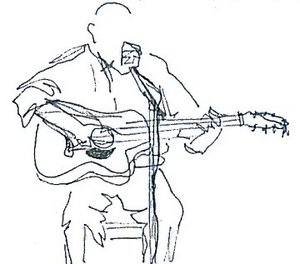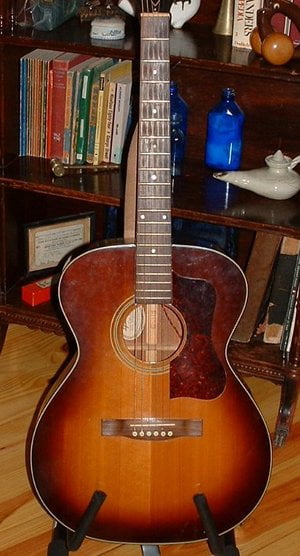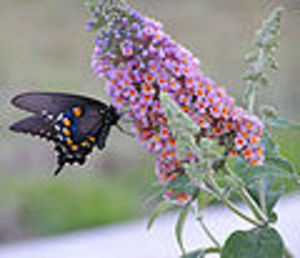It’s possible to become a good guitarist without taking lessons. I know, because I’ve been playing guitar for over fifteen years now and have become rather proficient at it, and I did it without the benefit of lessons.
This article is about how I did it, and how you can too, if you really want too.
Many guitar players begin when they’re relatively young. Not me. I didn’t learn to play in high-school, or college, though, I really wanted too. I’m not sure what stopped me. I guess I just never thought I had it in me. It wasn’t until some years later, when someone bought me a guitar as sort of a gag gift, that I really took learning to play very seriously.
The first hurdle, with me, as with most anyone that picks up a guitar, was getting my fingers used to pressing the strings down against the fret board. For anyone that’s ever tried, you know it can get pretty painful, pretty quickly. I also wasn’t willing to shell out any cash for lessons, so instead, I bought a couple of Mel Bay, intro to guitar books. In those books I learned how to form basic guitar chords and how to do some simple strumming. Nowadays, you can find pretty much everything you need on the Internet. Some of it is free, such as chord charts, some of it costs a little bit. I’ve posted some links at the end of this article to get you going. At any rate, in the beginning, that’s all you’ll really need..
It became clear after a couple of weeks, at least to me, that the reason people usually sign up for guitar lessons, is because they need someone to yell at them if they don’t practice. Since I really wanted to learn to play, I found I didn’t need someone to yell at me to make me practice. Plus, I discovered that not everything about learning to play guitar, is practice. Some of it can be about simply enjoying the sounds you can make with a guitar. If you think you might be someone that can get things done without someone yelling at you, than I suggest you try learning without an instructor.
In the beginning, I had trouble developing calluses. The skin on my fingers would harden and crack, which was of course very painful. Also, the joints of my fingers began to hurt. I worried I was damaging my fingers. But I kept on practicing anyway. I figured that my worries were due more to paranoia, than to anything else. If you want to learn to play guitar, whether on your own or otherwise, you’ll have to grit your teeth and just make yourself get past the hurting fingers stage. It won’t last that long. I survived, you will too
It also occurred to me that maybe I was practicing too much. In those first few weeks, I tried to play that guitar for several hours every day after work.
It took about a month for me to be able to press down on some chords and strum at the same time, and not have things sound muffled. But that was enough. Hearing a clean, clear tone coming from my guitar, gave me a euphoric feeling. It made me feel like I could eventually play.
So, I kept practicing and playing around. That’s one of the keys. If you want to learn, you have to stick with it, no matter what.
I practiced jumping between chords, because Mel Bay said it would be necessary to play songs. I practiced the songs in the books. I took me about six months to be able to play the simple songs in the book in a way that I thought sounded rather seamless. I was gaining confidence. You will too if you keep it up for six months.
Along the way, during those first six months as I was banging away on “Amazing Grace” and “Yellow Submarine,” I also began to try to accompany myself with singing, which wasn’t new for me. I’d been singing songs all of my life. Not professionally, but in church, at home, in the shower, with friends, etc. Singing was something I was comfortable with and singing while strumming chords gave me yet another feeling of euphoria. In my head, everything sounded so beautiful. I could hear my voice meshing with the tones of the guitar. I could feel myself being on key, or not, as it turned out at times. Suffice it to say, it was a rather eye-opening experience. Whether you’re a singer or not, you might try singing with your guitar. It helps to get your fingers doing things automatically.
I didn’t buy any new guitar books for six months after that. I wanted to first feel that I had not just learned the things that were being taught in the books, but to feel as though I was playing well enough to move forward.
After that six month period though, which meant I’d been playing for a year altogether, I went to the music store and splurged. I bought every book I could afford. Then, I subscribed to a couple of guitar-player type magazines. You can still subscribe to magazines, but you don’t really need to. Pretty much everything you need can be found free online. You might want to order some books though, because I’ve found that learning whole songs is a lot easier if you have something printed in a nice format that you can set on a sheet music stand.
Not much later, I bought my first electric guitar and amp. A truly heady experience all in itself as you will no doubt learn for yourself when you get yours.
I never have learned to read musical notation, but I did learn to read Tablature, a shorthand method of graphically representing how to play a song on a guitar. I learned right away, because it’s how magazines and books show you what notes and chords go with what songs and how to play them. Learning to read Tablature was very easy, something anyone can do in a matter of hours. It’s little more actually, than miniature pictures of a guitar neck with numbers on the frets telling you where to put your fingers. So, if you are thinking of teaching yourself to play, you definitely will want to learn how to read tablature, and as soon as possible.
To me, that first year of learning to play the guitar was sort of like a baby learning to stand upright and walk. In some ways it was complex, in other ways, it was all very basic. But at the end of that first year, I still wasn’t someone that most anyone would consider a guitar player. But just as learning to stand up and walk leads to running, and playing soccer or dancing, so too does getting the basics down pat before moving on to the more intricate parts of guitar playing. I highly recommend sticking with it once you’ve reached this point, because otherwise all your hard work will never give you a payoff.
The first thing I found after I bought books with more complicated things in them, was, the fact that I had a whole lot more chords to learn if I wanted to play the songs I’d grown up listening too on the radio. So that was where I focused. I bought myself a chord chart that showed exactly how to place my fingers for every chord imaginable, then picked out some songs, looked up the appropriate chords, and began to practice. The other thing I discovered was barr chords, which are basically chords you play up and down the neck, rather than down on just the low end.
It was hard. All of it. Maybe even harder than when first picking up the guitar. I’ve never been a so-called natural player. I never just “felt” how things were supposed to be. I had to slog through everything. The toughest part wasn’t fingering the chords though, it was hitting the strings just right. Or moving between them. In short, it was in trying to make the guitar sound the way it did on a song recorded on a CD.
It got even harder when I decided I needed to learn to play lead. For those that aren’t clear on this term, it means instead of strumming the guitar, you pick individual strings. or just a few of them. And while you do that with one hand, you manipulate the strings with the fingers of your other you generally use for pressing down the strings onto the frets. You do bends, and slides. And hammer-on’s and pull-off’s. Stuff like that. It’s the fancy guitar parts you hear during breaks in songs mostly, when the singer lets the guitar shine for a bit.
If you want to be considered a guitar player, you pretty much have to learn all these things. That’s the bad news. The good news is, it’s doable. You don’t have to have innate talent or an instructor. All you need is time, patience and perseverance.
Anyway, obviously, playing lead guitar is quite a challenge. It’s much harder on your fingers too. Once again I went through achy joints and tender fingertips. No doubt you will too. But it will be worth it, I promise.
But once again, I persevered. That was the key for me, and doubtless it would be also for anyone else learning to play. You have to get behind the music. To get past thinking about how you need to practice, to thinking more like how you “get” to play as soon as you get done with all the other necessary things in life.
That second year was tough, and frustrating at times. Sometimes I found some chords just too difficult to play. Other times, I couldn’t figure out what was being done on a CD. Or other times, I’d finally figure out that they’d used more than one guitar, so I’d have to learn both parts or drop the song and move on to something else.
But the thing is, throughout, I kept on playing. Sometimes songs I was working on. Sometimes just random stuff I’d make up as I sat there listening to myself play. That was another key to success I think. If you’re somebody who is interested in teaching yourself to play, make sure you learn to improvise so you won’t get stuck just trying to play something somebody else wrote all the time. Especially if you decide to get into some Jazz or Blues. Because sometimes, just sitting there, jamming with your own bad self, can be one of the most fulfilling experiences you’ll ever have with your guitar.
It was during that second year that I really began to think of myself as a guitar player. I could play easy songs pretty well. Good enough that others could sing along with me. I could also play some of the cooler licks I liked from a lot of different songs. But it was the ability to be able to just pick up my guitar, sit and, strum or pick; or go finger-style on some things, that made me feel like a player. I could do something with the thing, not just plunk around on it.
The years that came after were pretty much little more than refinement. The more you play the better you get, so long as you constantly challenge yourself. That’s the thing I would suggest to you, if you yourself are interested in teaching yourself how to play. Keep in mind that you have all the time in the world. There is no hurry. No rush. There’s no competition. There’s just you and your guitar. Go at your own pace. Do what you like and avoid what you don’t like. Eventually, the hard things get easier and you’ll find yourself enjoying what you can do. Hold on to those feelings, because that’s why you wanted to play in the first place.
I wouldn’t say that today I am good enough to play professionally, but I’m certainly good enough that most people around me enjoy my playing, and that’s really all I ever wanted in the first place. If you are someone that is considering teaching yourself to play, I would heartily suggest you give it a try. Truly, there is nothing standing in your way but your own hesitation. At worse, you’ll give up and move on to other things. At best though, you’ll add a new dimension to your existence. You’ll be known as a guitar player. And how cool is that?






